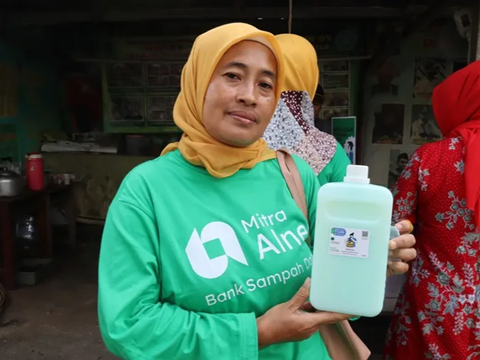
Unilever has laid out its six steps to unlock successful reusable and refillable packaging models, including advice for encouraging uptake among consumers and retailers – basing its findings on systems currently operating in Africa and Asia.
The TRANSFORM impact accelerator is a joint initiative between Unilever, the UK’s Foreign, Commonwealth & Development Office (FCDO) and EY. Its purpose is to support small and medium-sized enterprises (SMEs) and entrepreneurs in testing and scaling packaging models in a bid to solve such environmental challenges as plastic pollution.
In its new insights paper, TRANSFORM highlights learnings from four enterprises operating reuse-refill business models in Africa and Asia.
Alner combines low-tech refills and containers to enable shoppers to refill products from three of Unilever’s brands in Indonesia. Refillable, meanwhile, offers a reuse, refill and return service, through which Indian consumers can access home care products without relying on single-use packaging.
Bopinc’s refill station distribution models – as well as its campaign encouraging consumers to choose refillable options over single-use packaging – are based in Bangladesh and Kenya. Additionally, Novek, also based in Kenya, provides hardware and software solutions in an effort to eliminate single-use plastic from FMCG supply chains.
In its first finding, Unilever asserts that refill solutions can take time to establish. It says that partnerships must be developed between retailers, enterprises, and brand owners, with all three simultaneously working together to influence and change consumers’ shopping habits.
According to the paper, volume uptake can be slow to start with. Nor is every product suitable for refill models, it says, so the most compatible items should be prioritized, launched, and scaled quickly, with consumers supported through their expected behaviour change.
“Refill is a logical solution for brands and consumers to reduce waste and achieve long-term cost savings,” commented Bintang Ekananda, co-founder and CEO of Alner, Indonesia. “For retailers, it offers a unique value proposition. We’ve seen successful examples in Indonesia, proving its viability across the supply chain.”
Secondly, the paper claims that consumers prefer to bring their own reusable packaging to be refilled. They apparently prioritize functionality over aesthetics when it comes to home care products, but the opposite is true of personal care products. As such, Unilever recommends using labels to supply branding and product information on reusable containers.
It continues to state that the success of a high- or low-tech solution depends on the technology, consumer and regulatory requirements of any given market. High-tech machines are commended for their product quality, but can come at high costs – a drawback when operation with low margins on low-income markets.
Furthermore, they can be complicated to deploy and have ‘unexpected’ downsides, the paper says. For example, they can be more expensive to set up in countries that experience regular power cuts, as they then require additional support like battery backup.
When it comes to consumers, refill models are not only said to offer environmental benefits, but also to reduce costs. This is because consumers pay for the product and not the packaging, Unilever explains.
“Low-tech solutions are much easier to set up and scale across multiple locations, meaning they probably have more potential for creating impact at scale,” adds Zahid Mitha, CEO of Novek. “They also have lower operating costs which is beneficial in low-income markets.
“However, such models are not always possible because of local regulations, so government engagement is key. Both quality and quantity of product are more vulnerable to tampering.”
TRANSFORM also highlights the importance of building consumers’ trust in the quality of a product via dedicated strategies. The fear of product tampering can damage public perception of refill models.
Unilever suggests sampling as a low-tech solution. It is said to prove that the product quality is both ‘correct and consistent’ – but operators may also choose to install refill machines that report each dose back to the manufacturer, providing a more high-tech traceability solution.
Similarly, shopkeepers may express concerns about embracing refill technology, especially if it sacrifices valuable shelf space. Enterprises are encouraged to educate store owners on the environmental and financial perks associated with refill products, as well as train store owners to help them sell the idea to consumers and boost sales.
The paper’s sixth finding is that local ‘community champions’ like store owners and NGO leaders can influence consumers to get involved in reuse and refill schemes. Educational workshops are expected to provide information about refill concepts and their benefits, as well as build trust among the general public.
PA Consulting design strategy expert Matt Millington, alongside innovation and growth strategy expert David Knies, previously came to similar conclusions. Among other recommendations, they told us that consumers look for convenience and simplicity in a reuse system, but highlight that appealing aesthetics and marketing hype – for example, the popular Stanley cup with its limited-edition ranges and commercial partnerships – are beneficial in influencing consumer uptake.
Our senior writer, Victoria Hattersley, also authored a report highlighting the current roadblocks stifling progress in the reuse and refill landscape. These include unclear definitions of the terms themselves, inconsistencies in global legislation, and a lack of consumer uptake.
In other news, Unilever caused widespread discussion – and controversy – in the packaging industry when it modified its packaging sustainability targets back in April. This included backtracking on its original goal to make 100% of its packaging reusable, recyclable, or compostable by 2025; this target has been postponed to 2030 for rigid packaging and 2035 for flexibles. We spoke to global head of Packaging Pablo Costa to dive deeper into Unilever’s perspective on the change.
If you liked this story, you might also enjoy:
How are the top brands progressing on packaging sustainability?
Sustainable Innovation Report 2024: Current trends and future priorities
Reuse vs. single use – which is better for the environment?
The ultimate guide to global plastic sustainability regulation











No comments yet